Ground Fault Circuit Interrupter (GFCI) outlets are essential to electrical systems in homes and workplaces.
These specialized outlets serve a critical role in safeguarding both people and property by constantly monitoring the flow of electrical current.
Outlet reset is essential in order to maintain electrical safety, prevention against electrocution, fire prevention, and compliance with electrical codes.
Wondering how to reset the GFCI outlet?
In this article, we will delve into how the GFCI outlet can be reset, the purpose and importance of resetting GFCI outlets emphasizing the significance of this action in maintaining electrical functionality and ensuring safety.
In order to understand how to go about resetting a GFCI outlet, it is essential first to know what precisely a GFCI outlet is. Let us walk you through it:
A Ground Fault Circuit Interrupter (GFCI) outlet is a highly crucial safety device designed to protect people and prevent electric shock hazards by detecting ground faults.
Typically, the Ground Fault Circuit Interrupter Outlet is installed in an area where water and electricity are close to the bathroom, kitchen, garage, basement, and outdoors. They are beneficial for cord-connected appliances and equipment used outdoors or near water.
Understanding the role of GFCI outlets in electrical systems is vital for ensuring safety in homes and workplaces.
A GFCI outlet is also known as a Ground Fault Circuit Interrupter outlet. Its primary function is to monitor the flow of electrical current between a circuit's hot and neutral wires. Here's how it works:
The primary purpose of a GFCI outlet is shock prevention. By quickly cutting off the power when it detects a ground fault, it significantly reduces the risk of electric shock to anyone coming into contact with faulty electrical equipment or wet conditions, such as bathrooms, kitchens, or outdoor outlets.
Resetting a GFCI outlet is not just a routine task; it’s a vital commitment to electrical safety. By ensuring the continuous functionality of these outlets, we safeguard against electric shock, prevent potential fire hazards, and uphold compliance with electrical codes.

In summary, GFCI outlets are a vital component of electrical safety systems. They serve as safety devices by continuously monitoring electrical currents, detecting ground faults, and interrupting the circuit to prevent electrical shocks.
Understanding the role of GFCI outlets is essential for maintaining a safe and secure electrical environment in both residential and commercial settings.
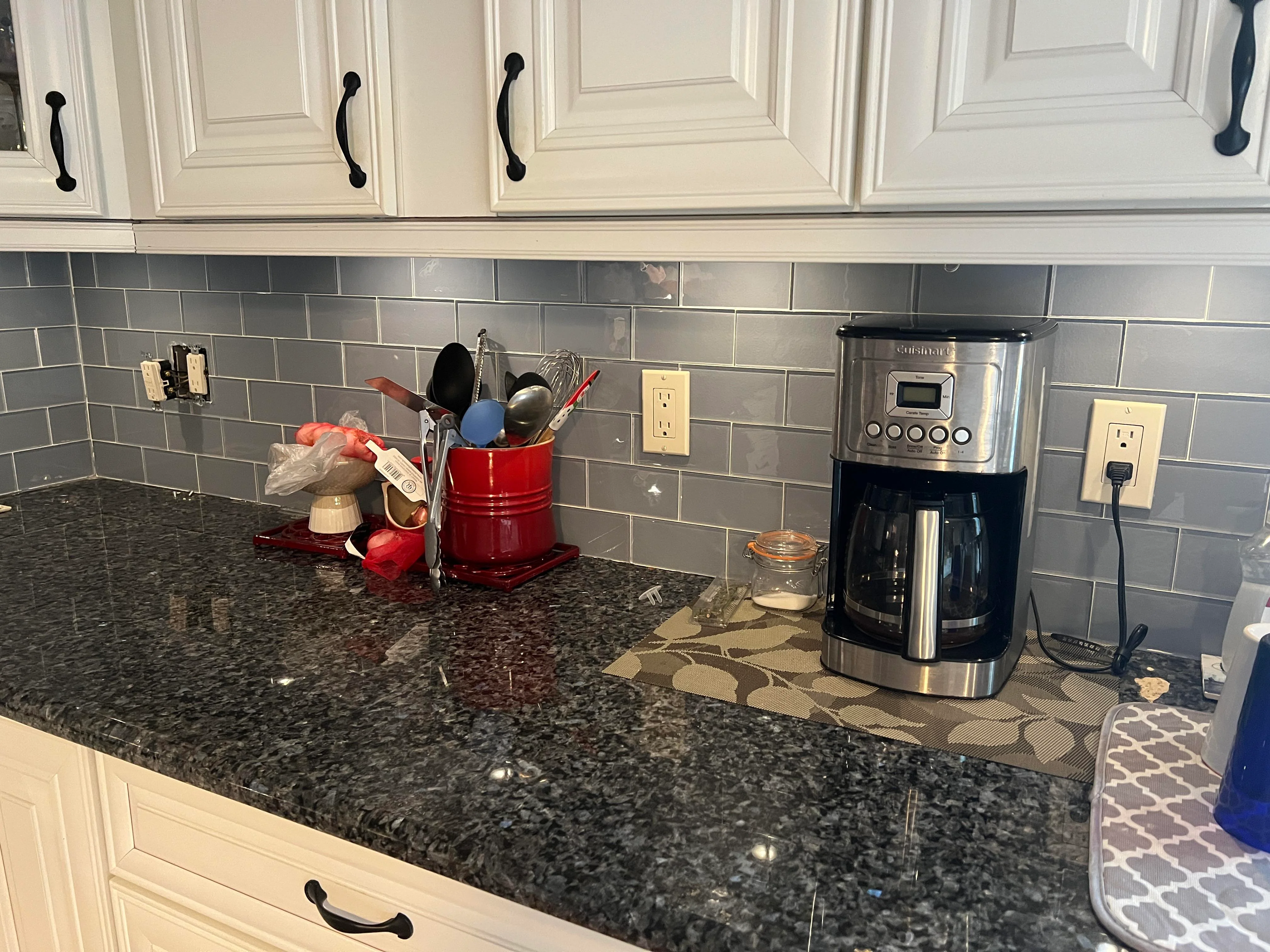
In order to ensure that there is electrical safety in your home and you can restore power, you must be able to find the tripped GFCI outlet and identify the "TEST" and "RESET" buttons. Here are the steps you can follow in order to find as well as reset the tripped GFCI outlet:
The first step is to visually inspect the outlets in the room or place where the power has been disrupted. Find outlets with two buttons, typically marked "TEST" and "RESET." The presence of these buttons makes it evident that the outlet is a GFCI.
You can begin your search by checking areas in which GFCI outlets are commonly installed. Wondering what these areas are? They can be bathrooms, kitchens, basements, garages, and outdoor spaces.
When you've located a GFCI outlet, firmly push the "RESET" button. After taking this procedure, the outlet and any related downstream outlets should have power again.
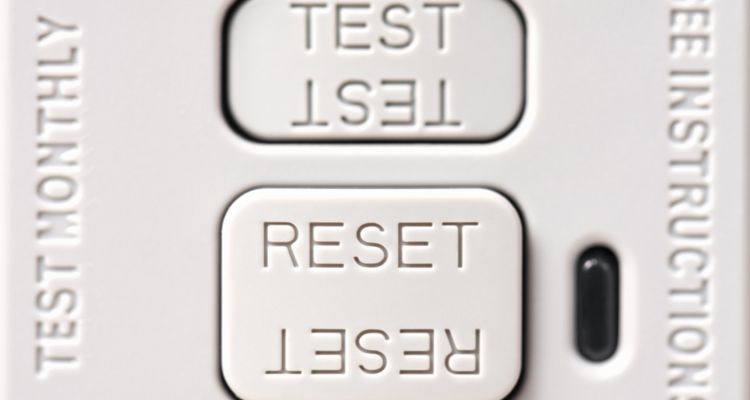
The outlet has been successfully reset if the button clicks and remains in place.
Plug in a small electrical device, such as a light or phone charger, to the GFCI outlet to ensure it is operating correctly. To check if the device is receiving electricity, turn it on.
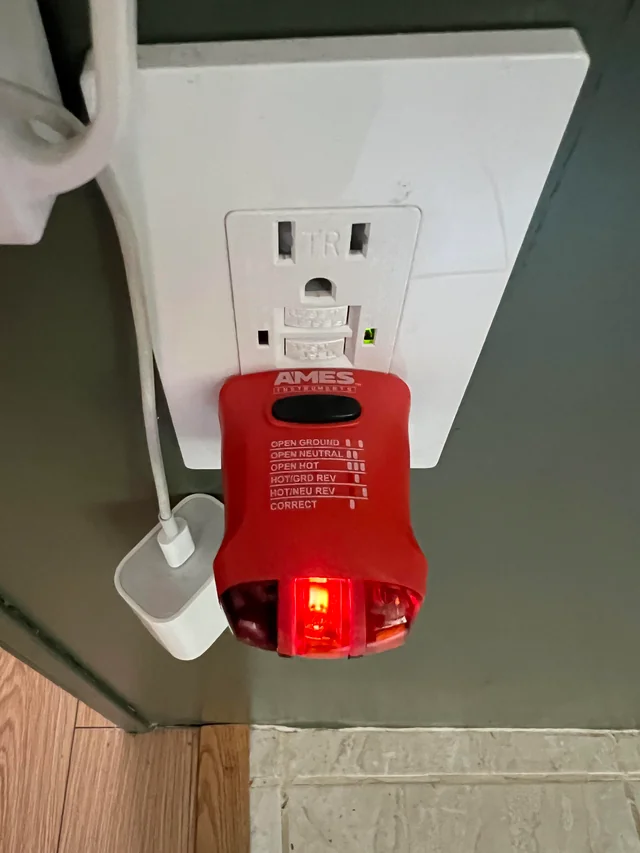
The GFCI outlet is operational if the device turns on. If not, move on to the following action.
Continue your search if the GFCI outlet you've located doesn't reset or if the outlet that tripped is not in the room you're inspecting.
A GFCI outlet may be upstream from the impacted region because GFCI outlets might be interconnected. Look for additional GFCI outlets in adjacent spaces, adjacent rooms, or nearby hallways.
You should also click the "RESET" button on any other GFCI outlets you find. To verify that the damaged outlet has been repaired, test it once more.
The tripped outlet may be on a separate circuit if you've looked in all neighboring GFCI outlets and are still unable to locate it. Check the circuit breaker panel in your house in this situation.
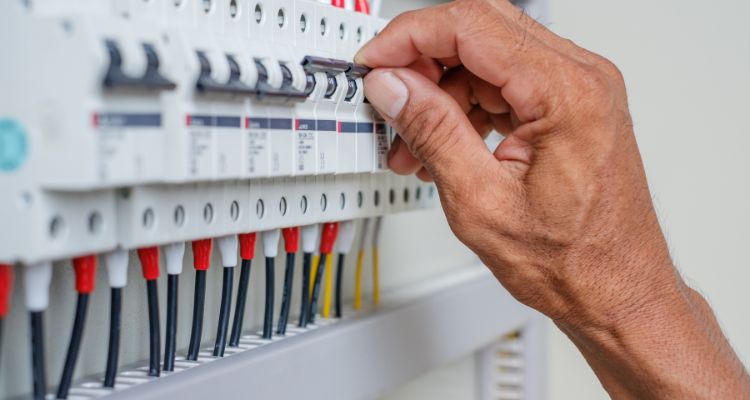
Look for a "GFCI"-labeled or otherwise tripped breaker. To restore power, reset the circuit breaker.
It's essential to speak with a certified electrician if you've tried these methods and are still unable to find the GFCI outlet that tripped or restored electricity. A more complicated or concealed electrical problem could need professional attention.
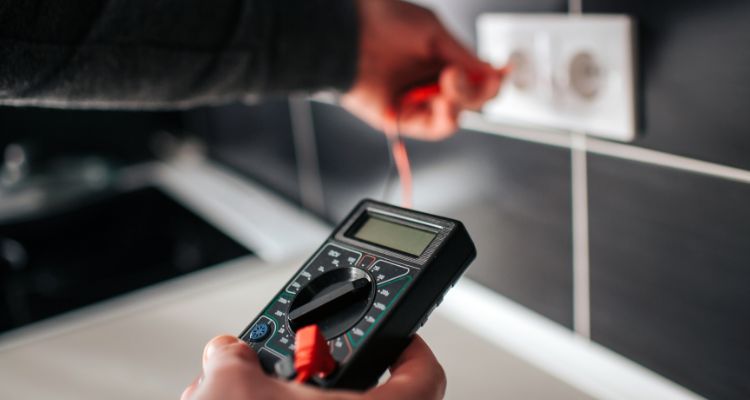
By following these instructions, you can effectively locate the tripped GFCI outlet and reset it, ensuring electrical safety and restoring power to the affected area in your home.
Resetting a tripped GFCI outlet is a straightforward process. Follow these steps to use the "RESET" button and restore power:
Following these steps, you can reset a tripped GFCI outlet using the "RESET" button, ensuring that it functions properly and providing the necessary protection against ground faults and electrical shocks.
To ensure the proper functioning of a GFCI outlet, it's essential to perform regular tests using the "TEST" and "RESET" buttons. Here's how to test the GFCI outlet to make sure it trips correctly and can be restored:
Regularly testing your GFCI outlets using the "TEST" and "RESET" buttons is a simple yet effective way to ensure their proper functionality. This proactive approach helps safeguard against electrical hazards and enhances the safety of your electrical system.
GFCI outlets play a critical role in electrical safety by preventing electrical shocks and are required or recommended in various locations within homes and outdoor spaces. Here are some common areas where GFCI outlets are either required or strongly recommended:
It's essential to adhere to local electrical codes and regulations, as they may specify additional locations where GFCI outlets are necessary.
Regular inspection and maintenance of GFCI outlets are also crucial to ensure they function correctly and provide the intended protection against ground faults and electrical shocks.
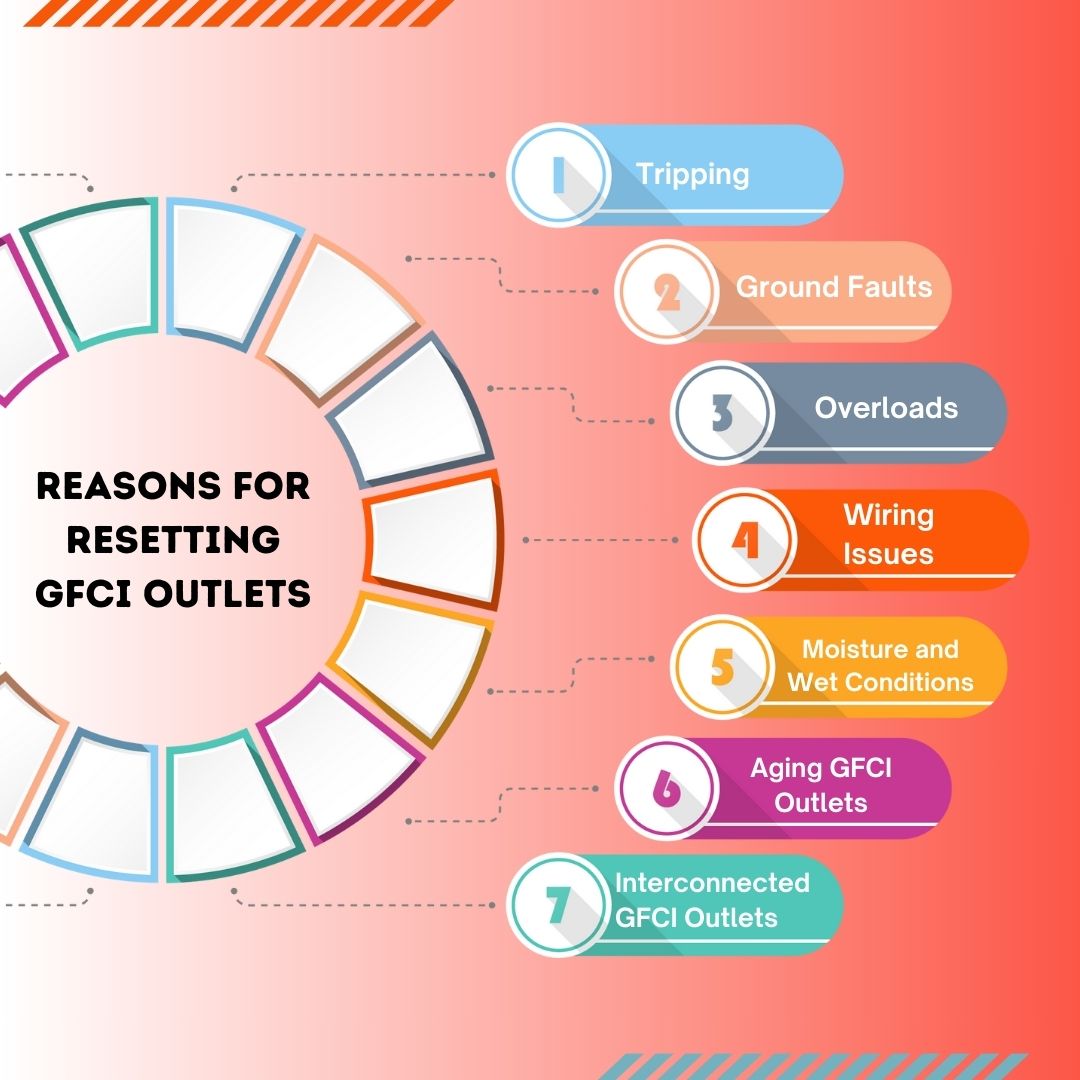
Tripping and Electrical Issues: GFCI outlets are designed to enhance electrical safety by continuously monitoring the flow of electrical current and responding to various electrical issues.
They may trip and require resetting for several reasons, including ground faults, overloads, or other electrical problems. Here's an explanation of these common causes:
Ground Faults: A GFCI outlet's primary function is to find ground faults. When electrical current mistakenly travels from the hot wire (the live wire) to a ground channel, as through water or a person, it is known as a ground fault.
The GFCI outlet trips to break the circuit when it detects an imbalance in the current flowing between the hot and neutral wires. This quick reaction stops dangerous electrocution and electric shocks.
Overloads: Electrical overloads can potentially cause GFCI outlets to trip. An overload occurs when too many electrical devices are plugged into the socket or when a broken item draws too much current.
Due to the abrupt rise in current, the GFCI outlet may identify this as a potential ground fault and trip to prevent overheating and fires.
Wiring Issues: Wiring issues or damage can cause GFCIs to trip. A loose connection can disrupt the electrical flow, a short circuit, or damaged insulation in the wiring, which will cause the GFCI to trip.
Moisture and Wet Conditions: Bathrooms, kitchens, outdoor spaces, and areas close to swimming pools are examples of moist situations that might enhance the likelihood of GFCI tripping.
Ground faults may result from unexpected electrical channels created by water. GFCI outlets are crucial in these places due to their sensitivity to such imbalances.
Aging or Malfunctioning GFCI Outlets: GFCI outlets may become worn out or have internal problems over time. The outlet could trip unnecessarily or fail to trip when there is a genuine ground fault if the internal circuitry is damaged or no longer operates properly.
To ensure ongoing safety in such circumstances, the GFCI outlet must be replaced.
Interconnected GFCI Outlets: Multiple GFCI outlets may be interconnected in some configurations. When one GFCI outlet trips, it may also cause other outlets farther down the circuit to trip.
This connector serves as a safety measure to guarantee the security of each outlet on the circuit.
Understanding the reasons behind GFCI outlet tripping is essential for maintaining electrical safety in your home or workplace.
When a GFCI outlet does trip, it's crucial to investigate the cause, address any underlying electrical issues, and reset the outlet to restore power while ensuring continued protection against ground faults and electrical hazards.
Repeated GFCI tripping can be a cause for concern, as it may indicate underlying electrical issues that require attention. Here are some insights into potential reasons for repeated GFCI tripping and when it's advisable to seek professional assistance for troubleshooting:
Excessive Moisture: Repeated tripping may occur if the environment around the GFCI outlet is frequently damp or humid. This can be the result of poor installation or poor weatherproofing. Make sure that the GFCI outlet and the area around it are sufficiently shielded from moisture.
Ground Faults in Appliances: Sometimes, the problem is with the appliances or gadgets connected to the GFCI outlet rather than the outlet itself. The GFCI may trip repeatedly due to a broken appliance that has a ground fault. To find the offending device, test each connected device.
Wiring Problems: GFCIs frequently trip due to faulty or broken wiring within the electrical circuit. Unbalanced current flow can be caused by loose connections, broken insulation, or overloaded circuits, which will trip the GFCI. Wiring problems can be inspected and fixed by qualified electricians.
Aging GFCI Outlets: GFCI outlets may deteriorate or lose sensitivity over time. In order to maintain dependable protection, it may be necessary to replace any outdated GFCI outlets that frequently trip.
Intermittent Ground Faults: Some ground faults may be intermittent, making locating them difficult. A licensed electrician can locate and diagnose intermittent ground faults if you're having frequent tripping without a clear cause.
Circuit Overloading: Too many high-powered gadgets plugged into one GFCI circuit can cause it to trip repeatedly, especially in older houses with insufficient electrical capacity. To lessen the load, think about redistributing devices across various circuits.
When to Call in a Professional for Troubleshooting:
You suspect wiring issues, especially if your home's wiring is old or hasn't been tested in a while.
It is advised to speak with a certified electrician in such circumstances. To maintain the security and effective operation of your electrical system, a qualified electrician can carry out a full inspection, find the source of the problem, and make the required repairs or replacements.
Always err on the side of caution and seek professional assistance when necessary because electrical problems can present significant risks.
In conclusion, understanding how to reset GFCI outlets is essential for guaranteeing electrical safety in your home or place of employment.
These outlets serve as watchful defenders, swiftly identifying ground defects and shutting electricity to avert potentially disastrous circumstances. Here are some further advice for dealing with GFCI-related problems:
You may maintain a safer electrical environment and lower the chances of ground faults and electrical accidents by following these suggestions and comprehending the importance of GFCI outlet resetting.
Electrical safety is a shared responsibility, and you can protect yourself and others around you by using your knowledge and taking appropriate action.